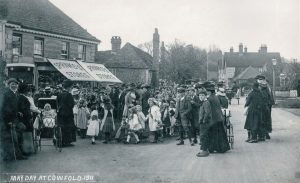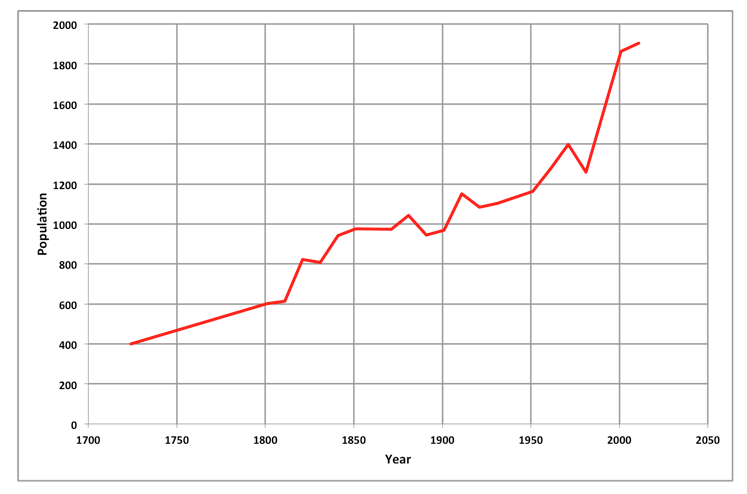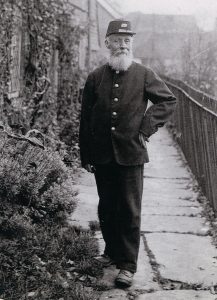
May Day at Cowfold 1911
In 1724, there were probably 60 families in the Cowfold area and a total population of less than 400; but discounting the outlying farms and houses there were probably no more than 150 people living in and around the village. By 1801 the parish population had increased to 601 and then to 1,042 in 1881, but dropped back to 944 in 1891. Today the village population is just under 2,000.

Cowfold Population from Census Data
In the 19th century Cowfold had a number of professional people, including the vicar and the surgeon or doctor, and one or two additions at various times, such as a surveyor in 1841; by 1871 Cowfold also had a non-conformist church minister. By 1841 Cowfold’s population also included 16 or 17 families of retired people and those living on investments or the income from land other than farmers. In 1851 the village included a former Port of London Customs Officer and a London silk mercer and twenty years later an actuary, a major general and a colliery proprietor. A number including some single women or widows relying on income from ‘the funds’ or as ‘annuitants’, lived in fairly modest village houses.

A postman in Church Terrace
Residents of the ‘big houses’ included William Borrer, a county magistrate, at Brook Hill from 1851 and William Boxall who lived in a mansion at Parkminster in 1871, staffed by six resident servants. Cowfold Lodge (south of Bull’s Bridge on the Henfield Road) in 1851 had a resident coachman and groom and a footman besides three other servants while there was a staff of six to run James White’s “convenient and pleasantly situated mansion” at Woldringfold. A member of the Loder family lived at the Clock House (built in 1914) on the road (now the A272) to West Grinstead.
Domestic labour in the 19th century represented one of the main sources of work for young girls. Apart from the labouring households most houses had one or more domestic servants. In 1871 there were some 85 resident domestic servants and farm servants representing about 20% of the working population of Cowfold. But there were also the non-resident servants with families and dwellings around the parish. These increased steadily between 1841 and 1871 when they accounted for 10% of the population. Included among these were coachmen and grooms, charwomen and domestic servants and gardeners (eleven households in 1871).
There were also those who were unable to support themselves and who relied on parish and other support. By 1871 the very poor – the pauper households – which had accounted for 6% of the population in 1841, had decreased to a couple of families.
Some families have been in Cowfold for many centuries; these include the Lintotts, Mitchells, Dunstalls, Bulls, Roberts and Gratwickes. From the 18th century an increasing number of families came from outside the parish, some of whom were absentee landlords. The Blunt family of Lindfield, and later of Horsham, owned Cratemans before 1700 and still lived there in the 19th century; Charles Goring of Wiston acquired Hill Farm about 1780 and then Brownings and Jervis in around 1815; and the Farrens came to Cowfold around 1888.
The Godmans, had a significant influence on Cowfold, both as a land owner and through involvement in the running of the village and its school. They came to Cowfold in the late 1800s and owned a number of large properties and estates in the area, including South Lodge (now the South Lodge hotel), home of Frederick Godman and Woldringfold, the home of his brother Charles. Frederick Godman was the benefactor of the Village Hall, Charles Godman served as chairman of the Parish Council at the outbreak of the First World War, and as Chairman of the St Peter’s School governors, and the Godman family owned the land which is now the village playing fields; these were let in the early 1900s to the cricket club and were also used for stoolball and football.
